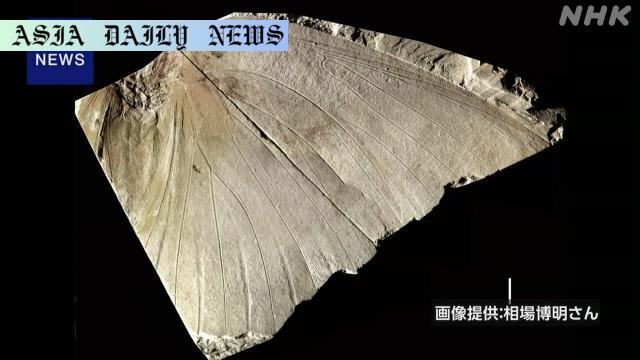Butterfly Fossil – A fossil of a butterfly in Japan discovered 37 years ago has now been identified as a new extinct species.

A Rare and Outstanding Discovery of a Butterfly Fossil
In an extraordinary finding that sheds light on the history of butterflies, a butterfly fossil discovered in Japan 37 years ago has now been identified as a new species. This remarkable discovery, unearthed from a 2.5 million-year-old stratum in Shinonsen Town, Hyogo Prefecture, represents not only a rare glimpse into a long-extinct species but also holds the distinction of being the largest butterfly fossil ever discovered. With an estimated wingspan of 84 millimeters, this extraordinary specimen provides invaluable data for understanding the evolution of butterflies.
Unearthed in 1988 and preserved in a local museum, the fossil had remained a subject of mystery for decades until Japanese researchers, led by Aiba Hiroaki of Keio Yokohama Elementary School, subjected it to further scrutiny. Using cutting-edge high-performance microscopy, the researchers identified unique characteristics in the fossil’s wings and abdomen, leading to the conclusion that it belongs to a previously unknown species. The specimen has since been classified as part of the Tacola genus, which includes related species found today in subtropical and tropical regions of Southeast Asia. Despite belonging to the same genus, this extinct species no longer exists in the wild.
The Challenges of Butterfly Fossil Discoveries
Butterfly fossils are exceptionally scarce in the fossil record due to the insects’ delicate, fragile structures. Unlike plant or shell fossils, which are more robust and often preserved in favorable conditions, butterfly wings and bodies are buoyant and easily decomposed. The discovery of this 2.5 million-year-old specimen, therefore, represents an exceptional find in paleontological research. The fossil’s rarity underscores its significance in understanding how environmental and evolutionary factors have influenced butterflies over millions of years. Fossils such as this enable scientists to track periods of biodiversity, extinction events, and environmental shifts, making them critical to evolutionary biology.
The Scientific Importance and Broader Implications
In addition to being the largest butterfly fossil recorded to date, this discovery is an important contribution to the global inventory of insect fossils, which is comparatively smaller compared to plant and vertebrate records. Fossils not only provide proof but also act as clues when exploring the evolutionary history of organisms. As noted by researcher Aiba, the scientific community greatly benefits from such rare findings, which help connect pieces of nature’s evolutionary puzzle. Moreover, learning about extinct species could help guide conservation efforts at a time when modern-day butterflies are threatened by habitat loss, climate change, and pesticide use.
The identification of this fossil as a new species further indicates that Japan may have once hosted a more diverse and unique butterfly population. The environmental conditions during the era when this species thrived likely made it a suitable habitat for such insects, which evolved to endure. It also compels scientists to question how climatic shifts over millennia led to the species’ eventual extinction.
Conclusion: A Testament to Nature’s Complexity
The perseverance of researchers and continuous technological advancements are critical for uncovering natural wonders like these. The discovery of the largest butterfly fossil serves as a testament to the power of research in piecing together Earth’s history while providing key insights into the world of entomology. This finding not only raises the curiosity of scientists but also inspires a broader appreciation for the fragility of ecosystems and the importance of preserving biodiversity. With this fossil declared scientifically invaluable, it will undoubtedly lead to further studies and discussions in the field of paleontology and evolutionary biology.
Commentary
Understanding the Significance of This Discovery
The discovery of the largest butterfly fossil to date is not just an achievement in paleontology but a reminder of the delicate balance within nature’s ecosystems. It highlights how even the most fragile of organisms, like butterflies, can leave an impactful mark on the evolutionary record. It also illustrates the rarity and difficulty of making such discoveries due to the insect’s delicate structure, which often does not survive the fossilization process.
This finding opens up new avenues for understanding how insects, particularly butterflies, adapted to changing climates and environmental conditions millions of years ago. It offers a unique opportunity to study evolutionary biology. The fact that this species belongs to the Tacola genus, which places it in relation to present-day subtropical species, makes us wonder about the climatic differences that allowed this species to thrive in Japan during its era. Understanding these environmental factors is crucial, particularly as we face climate challenges affecting modern-day biodiversity.
Reflections on Conservation and the Power of Discovery
As researchers delve into studying fossils like this one, their efforts bring to light not only the marvels of species that no longer exist but also what their extinction could mean for current ecosystems. The evolutionary loss of this butterfly species serves as a stark reminder of the fragility of biodiversity. In a time where modern-day butterfly populations are struggling to survive amid environmental changes, studies like these gain heightened importance.
Furthermore, such discoveries enrich our understanding of the past, offering a timeline of life that links ancient ecosystems to their present-day counterparts. As a society, it encourages us to value the invaluable history contained within our planet’s strata. Fossils like this are more than just preserved remains; they are stories frozen in time, speaking to the resilience and vulnerability of nature’s complex systems.
A Message on Curiosity and Scientific Research
This discovery is a testament to the dedication of researchers and the importance of safe-keeping fossils in local museums until modern technology can do justice to their examination. With advancements in microscopy and imaging techniques, even the most fragile specimens, such as butterfly fossils, can reveal information that was previously unattainable. This rare find from Japan’s Hyogo Prefecture invites paleontologists across the globe to continue their exploration of Earth’s rich and intriguing history, unraveling mysteries while providing profound insights into the world we now inhabit.


